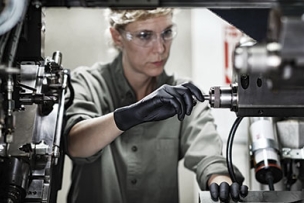MCR Safety has over forty years of experience as a leader in the field of personal protective equipment (PPE). Our assortment of offerings includes gloves, glasses, and garments which are made from the highest quality materials available to ensure maximum safety, comfort, and style.
What are gloves made out of? Let's first stress this is a complex answer to a relatively simple question most would consider. Protecting today's modern-day workers from all the potential workplace hazards requires a wide assortment of options. So asking which glove material makes up most of MCR Safety's gloves opens up a lengthy discussion.
Work gloves are essential for protecting workers' hands across almost every industry. They are made from different materials to cater to specific tasks, hazards, and environments. As you can imagine, MCR's glove portfolio has ballooned to over 1,000 gloves utilizing many different materials over time. Today, MCR Safety's work glove lineup consists of roughly 49 materials, utilizing numerous synthetic coatings, man-made fibers, and organic materials. The list of glove materials runs from natural, such as bamboo and cotton, to synthetic string knit materials, such as DuPont™ Kevlar®.
How did MCR Safety reach a point where 40+ glove materials were necessary for producing work gloves? Until 1970, leather, cotton, and jersey fabrics represented most of the industry's hand protection offerings. MCR encourages you to read their OHS article, The Golden Era of Hand Protection, which provides a historical overview of how they got here. They are in the Golden Age of protecting people's hands.
In general, the different materials improve a glove in one of three areas:
- Better comfort
- Better fit
- Better overall protection
So, what are gloves made out of? MCR Safety will keep this article short as possible and only cover some of the most requested materials for gloves. At the very end of the article, they will also point you toward other articles that dive deeper into glove materials around specific product lines, such as disposable gloves, rain gear, etc. MCR highlights the best materials for gloves:
High-Performance Cut-Resistant Material
Many work gloves incorporate high-performance cut-resistant fibers, essential for workers in industries that involve handling sharp objects. High-performance materials provide users with the most significant protection. Because of their enhanced features, there has been a progressive shift to utilizing more seamless knit shells as liners.
Since OSHA was founded in 1970, the quality of PPE technology has significantly improved, most notably with the advent of recent cut-resistant technologies. High-performance work gloves offer enhanced abrasion, cut, tear, thermal, and puncture resistance protection. The most common, DuPont™ Kevlar® and DSM Dyneema®, are covered more in the next section.
MCR highlights the most requested high-performance materials in their product lineup.
Aramid Fibers
Aramid fibers create gloves made from a strong, lightweight synthetic fiber that provides exceptional cut and puncture resistance. They are often used in industries that handle sharp objects like glass and metal. Manufacturing industries, such as automotive, are heavy users of aramid-based products.
Below are the two fibers MCR utilizes in producing work gloves:
KEVLAR® fibers withstand temperatures of up to 900°F, making it ideal for cut hazards that involve heat. Its tensile strength is five times stronger than steel in its ability to withstand the amount of tension applied. MCR Safety is a DuPont-licensed manufacturer of KEVLAR® brand fiber. MCR Safety is unique in being the only licensed manufacturer that also spins their KEVLAR® yarn.
MCR Safety released a brand-new aramid cut-resistant fiber in 2020. ARX technology provides both cut and heat resistance at affordable price points.
The following link will take you to MCR's section on their glove catalog for all aramid gloves. For more on aramids fibers, check out the article An Overview of Aramid Fibers which highlights this important high-performance fiber.









Talk to Us!
Would you have "chemical breakthrough chart" for gloves (PPE)?
6Leave a reply
Your email address will not be published. Required fields are marked *